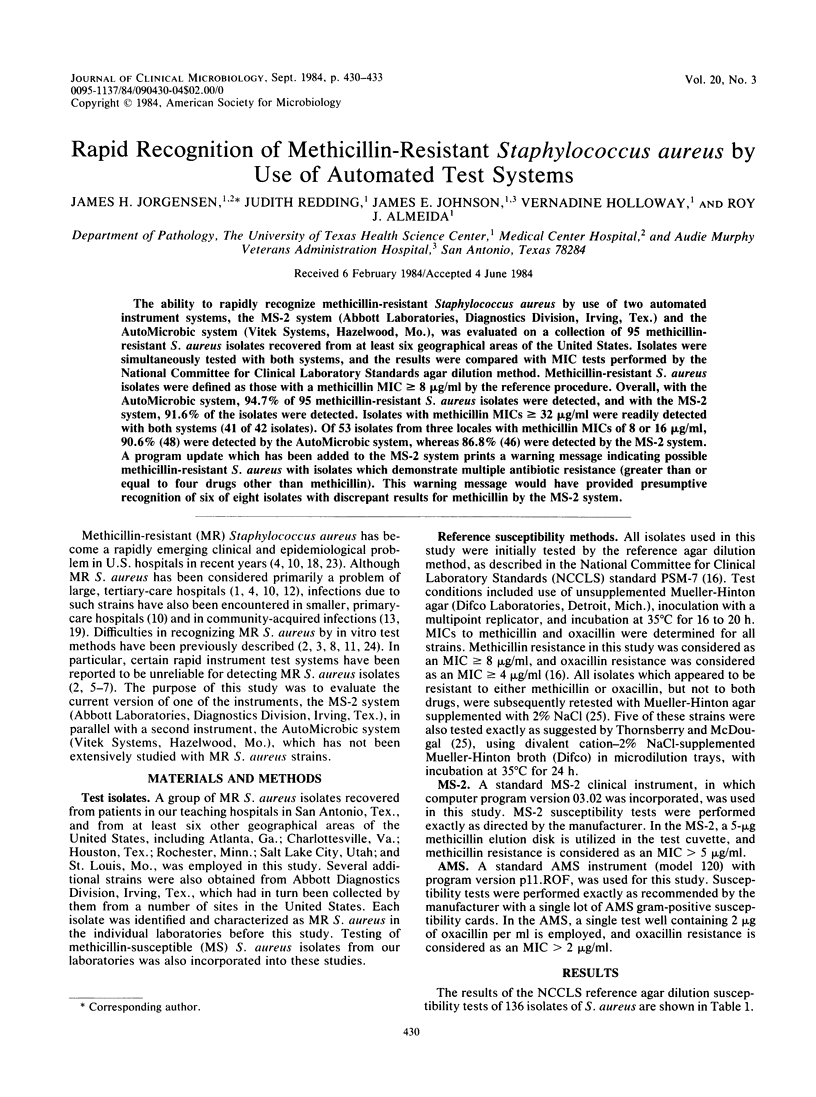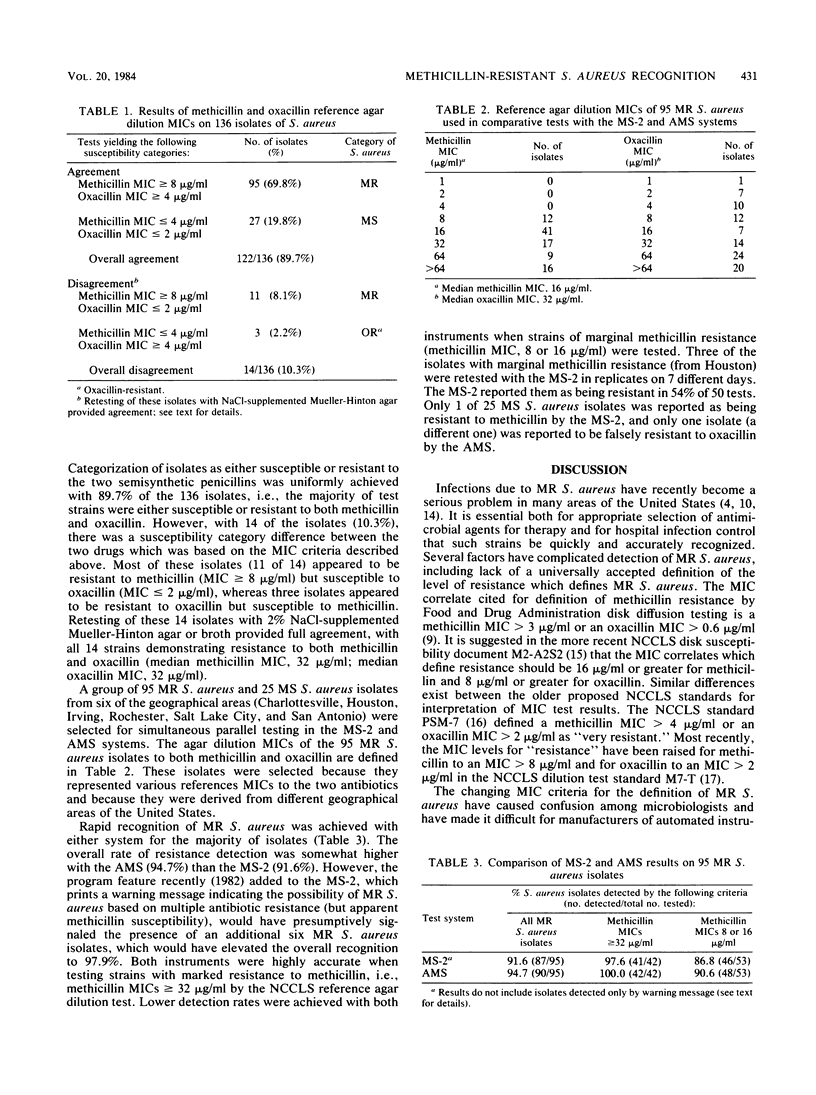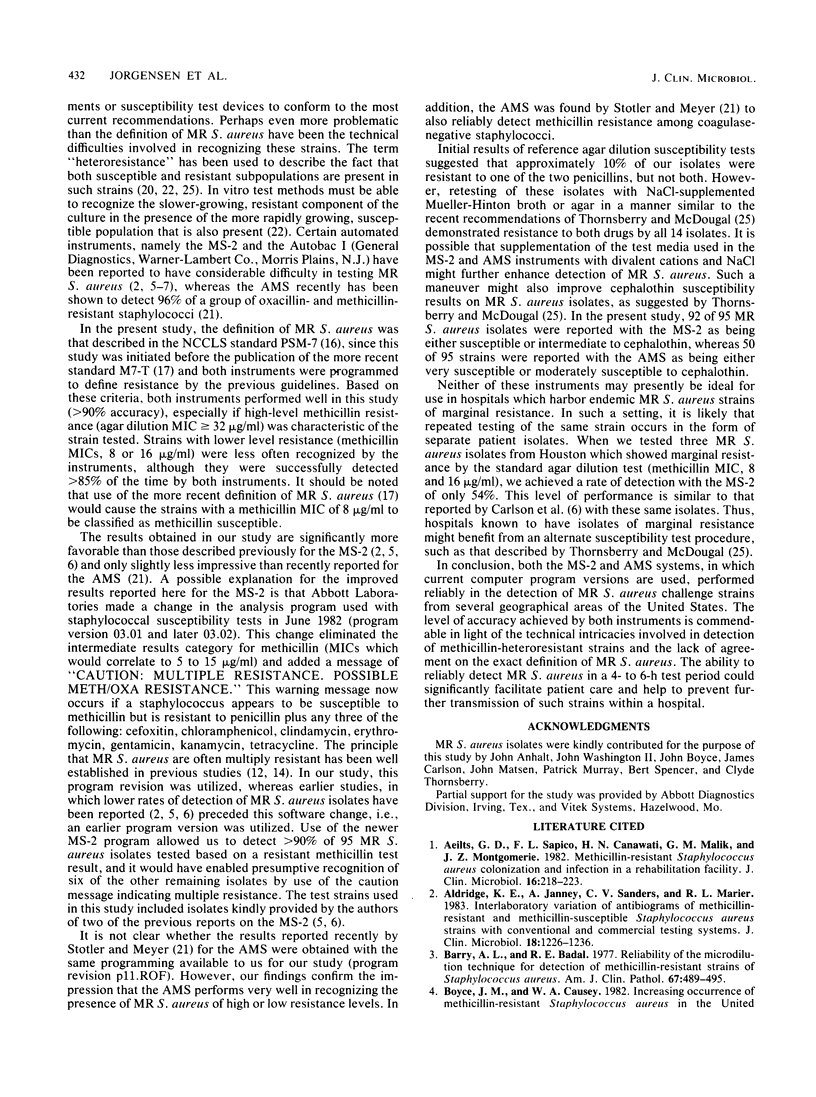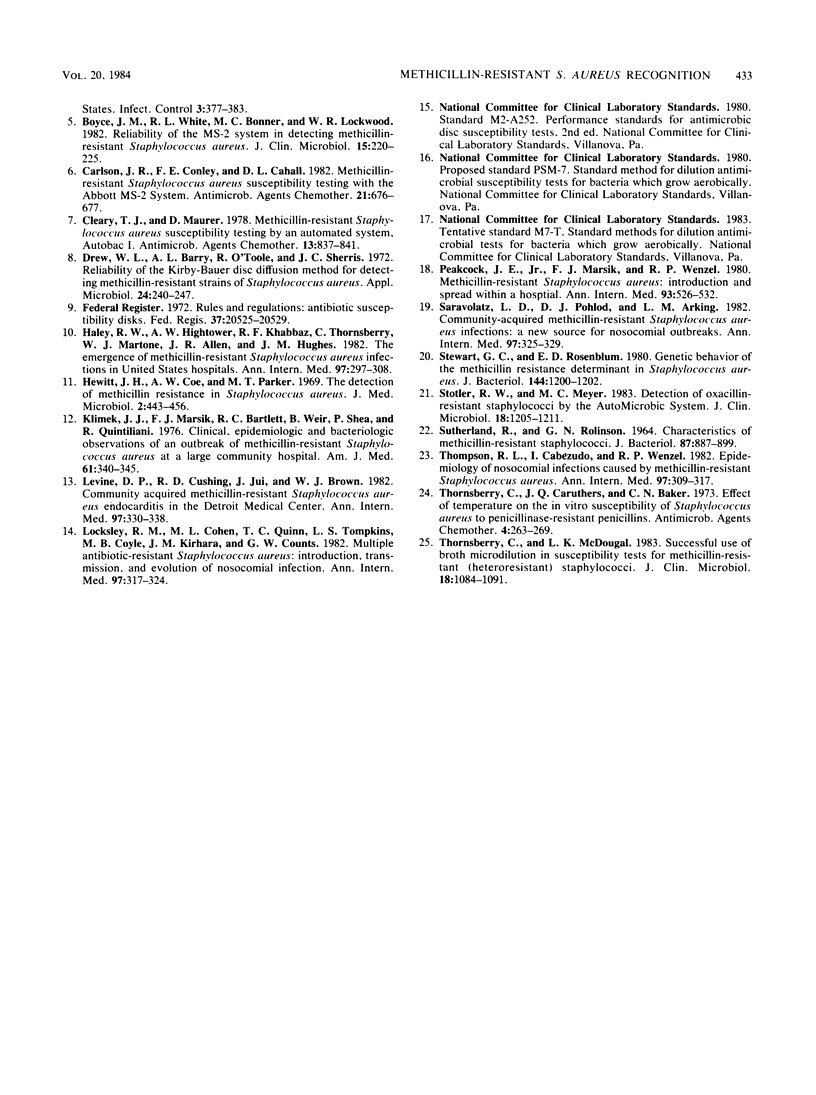Abstract
The ability to rapidly recognize methicillin-resistant Staphylococcus aureus by use of two automated instrument systems, the MS-2 system (Abbott Laboratories, Diagnostics Division, Irving, Tex.) and the AutoMicrobic system (Vitek Systems, Hazelwood, Mo.), was evaluated on a collection of 95 methicillin-resistant S. aureus isolates recovered from at least six geographical areas of the United States. Isolates were simultaneously tested with both systems, and the results were compared with MIC tests performed by the National Committee for Clinical Laboratory Standards agar dilution method. Methicillin-resistant S. aureus isolates were defined as those with a methicillin MIC greater than or equal to 8 micrograms/ml by the reference procedure. Overall, with the AutoMicrobic system, 94.7% of 95 methicillin-resistant S. aureus isolates were detected, and with the MS-2 system, 91.6% of the isolates were detected. Isolates with methicillin MICs greater than or equal to 32 micrograms/ml were readily detected with both systems (41 of 42 isolates). Of 53 isolates from three locales with methicillin MICs of 8 or 16 micrograms/ml, 90.6% (48) were detected by the AutoMicrobic system, whereas 86.8% (46) were detected by the MS-2 system. A program update which has been added to the MS-2 system prints a warning message indicating possible methicillin-resistant S. aureus with isolates which demonstrate multiple antibiotic resistance (greater than or equal to four drugs other than methicillin). This warning message would have provided presumptive recognition of six of eight isolates with discrepant results for methicillin by the MS-2 system.
Full text
PDF



Selected References
These references are in PubMed. This may not be the complete list of references from this article.
- Aeilts G. D., Sapico F. L., Canawati H. N., Malik G. M., Montgomerie J. Z. Methicillin-resistant-Staphylococcus aureus colonization and infection in a rehabilitation facility. J Clin Microbiol. 1982 Aug;16(2):218–223. doi: 10.1128/jcm.16.2.218-223.1982. [DOI] [PMC free article] [PubMed] [Google Scholar]
- Aldridge K. E., Janney A., Sanders C. V., Marier R. L. Interlaboratory variation of antibiograms of methicillin-resistant and methicillin-susceptible Staphylococcus aureus strains with conventional and commercial testing systems. J Clin Microbiol. 1983 Nov;18(5):1226–1236. doi: 10.1128/jcm.18.5.1226-1236.1983. [DOI] [PMC free article] [PubMed] [Google Scholar]
- Barry A. L., Badal R. E. Reliability of the microdilution technic for detection of methicillin-resistant strains of staphylococcus aureus. Am J Clin Pathol. 1977 May;67(5):489–495. doi: 10.1093/ajcp/67.5.489. [DOI] [PubMed] [Google Scholar]
- Boyce J. M., Causey W. A. Increasing occurrence of methicillin-resistant Staphylococcus aureus in the United States. Infect Control. 1982 Sep-Oct;3(5):377–383. doi: 10.1017/s0195941700057337. [DOI] [PubMed] [Google Scholar]
- Boyce J. M., White R. L., Bonner M. C., Lockwood W. R. Reliability of the MS-2 system in detecting methicillin-resistant Staphylococcus aureus. J Clin Microbiol. 1982 Feb;15(2):220–225. doi: 10.1128/jcm.15.2.220-225.1982. [DOI] [PMC free article] [PubMed] [Google Scholar]
- Carlson J. R., Conley F. E., Cahall D. L. Methicillin-resistant Staphylococcus aureus susceptibility testing with Abbott MS-2 system. Antimicrob Agents Chemother. 1982 Apr;21(4):676–677. doi: 10.1128/aac.21.4.676. [DOI] [PMC free article] [PubMed] [Google Scholar]
- Cleary T. J., Maurer D. Methicillin-resistant Staphylococcus aureus susceptibility testing by an automated system, Autobac I. Antimicrob Agents Chemother. 1978 May;13(5):837–841. doi: 10.1128/aac.13.5.837. [DOI] [PMC free article] [PubMed] [Google Scholar]
- Drew W. L., Barry A. L., O'Toole R., Sherris J. C. Reliability of the Kirby-Bauer disc diffusion method for detecting methicillin-resistant strains of Staphylococcus aureus. Appl Microbiol. 1972 Aug;24(2):240–247. doi: 10.1128/am.24.2.240-247.1972. [DOI] [PMC free article] [PubMed] [Google Scholar]
- Haley R. W., Hightower A. W., Khabbaz R. F., Thornsberry C., Martone W. J., Allen J. R., Hughes J. M. The emergence of methicillin-resistant Staphylococcus aureus infections in United States hospitals. Possible role of the house staff-patient transfer circuit. Ann Intern Med. 1982 Sep;97(3):297–308. doi: 10.7326/0003-4819-97-3-297. [DOI] [PubMed] [Google Scholar]
- Hewitt J. H., Coe A. W., Parker M. T. The detection of methicillin resistance in Staphylococcus aureus. J Med Microbiol. 1969 Nov 4;2(4):443–456. doi: 10.1099/00222615-2-4-443. [DOI] [PubMed] [Google Scholar]
- Klimek J. J., Marsik F. J., Bartlett R. C., Weir B., Shea P., Quintiliani R. Clinical, epidemiologic and bacteriologic observations of an outbreak of methicillin-resistant Staphylococcus aureus at a large community hospital. Am J Med. 1976 Sep;61(3):340–345. doi: 10.1016/0002-9343(76)90370-3. [DOI] [PubMed] [Google Scholar]
- Levine D. P., Cushing R. D., Jui J., Brown W. J. Community-acquired methicillin-resistant Staphylococcus aureus endocarditis in the Detroit Medical Center. Ann Intern Med. 1982 Sep;97(3):330–338. doi: 10.7326/0003-4819-97-3-330. [DOI] [PubMed] [Google Scholar]
- Locksley R. M., Cohen M. L., Quinn T. C., Tompkins L. S., Coyle M. B., Kirihara J. M., Counts G. W. Multiply antibiotic-resistant Staphylococcus aureus: introduction, transmission, and evolution of nosocomial infection. Ann Intern Med. 1982 Sep;97(3):317–324. doi: 10.7326/0003-4819-97-3-317. [DOI] [PubMed] [Google Scholar]
- Peacock J. E., Jr, Marsik F. J., Wenzel R. P. Methicillin-resistant Staphylococcus aureus: introduction and spread within a hospital. Ann Intern Med. 1980 Oct;93(4):526–532. doi: 10.7326/0003-4819-93-4-526. [DOI] [PubMed] [Google Scholar]
- SUTHERLAND R., ROLINSON G. N. CHARACTERISTICS OF METHICILLIN-RESISTANT STAPHYLOCOCCI. J Bacteriol. 1964 Apr;87:887–899. doi: 10.1128/jb.87.4.887-899.1964. [DOI] [PMC free article] [PubMed] [Google Scholar]
- Saravolatz L. D., Pohlod D. J., Arking L. M. Community-acquired methicillin-resistant Staphylococcus aureus infections: a new source for nosocomial outbreaks. Ann Intern Med. 1982 Sep;97(3):325–329. doi: 10.7326/0003-4819-97-3-325. [DOI] [PubMed] [Google Scholar]
- Stewart G. C., Rosenblum E. D. Genetic behavior of the methicillin resistance determinant in Staphylococcus aureus. J Bacteriol. 1980 Dec;144(3):1200–1202. doi: 10.1128/jb.144.3.1200-1202.1980. [DOI] [PMC free article] [PubMed] [Google Scholar]
- Stotler R. W., Meyer M. C. Detection of oxacillin-resistant staphylococci by the AutoMicrobic system. J Clin Microbiol. 1983 Nov;18(5):1205–1211. doi: 10.1128/jcm.18.5.1205-1211.1983. [DOI] [PMC free article] [PubMed] [Google Scholar]
- Thompson R. L., Cabezudo I., Wenzel R. P. Epidemiology of nosocomial infections caused by methicillin-resistant Staphylococcus aureus. Ann Intern Med. 1982 Sep;97(3):309–317. doi: 10.7326/0003-4819-97-3-309. [DOI] [PubMed] [Google Scholar]
- Thornsberry C., Caruthers J. Q., Baker C. N. Effect of temperature on the in vitro susceptibility of Staphylococcus aureus to penicillinase-resistant penicillins. Antimicrob Agents Chemother. 1973 Sep;4(3):263–269. doi: 10.1128/aac.4.3.263. [DOI] [PMC free article] [PubMed] [Google Scholar]
- Thornsberry C., McDougal L. K. Successful use of broth microdilution in susceptibility tests for methicillin-resistant (heteroresistant) staphylococci. J Clin Microbiol. 1983 Nov;18(5):1084–1091. doi: 10.1128/jcm.18.5.1084-1091.1983. [DOI] [PMC free article] [PubMed] [Google Scholar]


